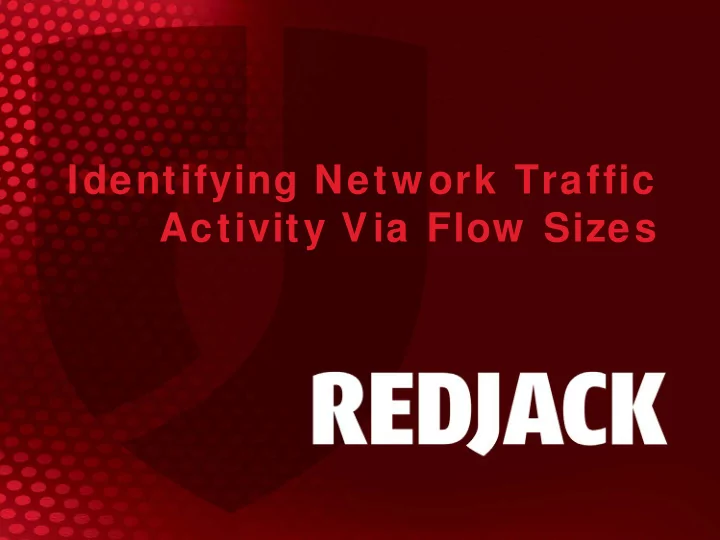

Identifying Network Traffic Activity Via Flow Sizes
Overview • Motivation – identifying activity via payload • Theory behind the idea • Measuring NetFlow • Measuring DNS traffic captures • Implications and future work
Motivation • Users don’t have the common decency to send plaintext all over the place anymore • HTTPS prevalence • OTR encryption for IM • SSL for email
This Expands on Previous Work • 2007 Paper on BitTorrent detection that focused on multiple behaviors – fumbling, file transfers, &c • Now doing in depth study of control messages to see what we can find – Advantage – this time, have payload • Questions: – Size of control messages – Distribution of control messages – Frequency of combinations?
Identifying Protocols Via Flow Sizes • Hypothesis: traffic consists of three families of data – “Chatter” • Short (< MTU) , roughly symmetric packets of variable size • SSH, Telnet, IRC, ICQ, AIM – Transfer • MTU packets, met by payload-zero packets • FTP, Mail, HTTP – Control • < MTU packets, fixed sizes “fill in the blank” templates • All protocols
Differentiate Via Control Message Sizes Histogram CDF SMTP HTTP
Done Some of This Already • 2007 paper on p2p identification showed that you could find BitTorrent by looking for specific behaviors – Control packet sizes were one particular behavior • However… – What are the actual packets? – What are the sizes • Didn’t have ground truth in previous work – Now have access to it via DNS records
DNS Analysis • Using DNS data, we can compare the exact messages sent against packet sizes • See what messages produce what packet sizes • Determine if we can predict messages via sizes • Can’t predict content , but we can guess what the user was looking for
The DNS Datagram Q A T R R • State is maintained by OpCode Z RCODE R A D A C Query ID • Other flags set various info – authoritative, recursive, &c • Response is sent in one Query ID or more RR’s (resource QDCount ANCount records) NSCount ARCount Resource Records… 16 0 31
Resource Records and DNS Information • DNS handles a lot of information – Name lookup – Name ownership – Authentication – Redirection – Email
Ripping Apart DNS Message Contents • A DNS message contains 1 or more RR’s (resource records) – Different RR’s serve different purposes – Each RR has a different format, although most contain at least one variable length domain name • Multiple different RR’s may be sent to comprise a single message • There’s no requirement that the RR’s actually be related to the original query, they may be annotative information • ~40 RR’s currently defined, including a couple of optional ones • Responses are rarely just one message
Multiple Records Will Appear Simultaneously A AAAA CNAME MX NS OPT SOA TXT A 99.33 100.00 52.56 98.15 99.33 99.30 99.59 50.00 AAAA 0.00 0.00 0.00 0.00 0.00 0.00 0.00 0.00 CNAME 0.69 0.00 1.30 0.00 1.30 1.36 0.00 0.00 MX 1.88 0.00 0.00 1.90 1.90 0.11 69.18 50.00 NS 100.00 100.00 100.00 100.00 100.00 100.00 100.00 100.00 OPT 49.56 0.00 52.03 2.94 49.57 49.57 0.41 50.00 SOA 2.65 0.00 0.00 96.29 2.65 0.02 2.65 50.00 TXT 0.00 0.00 0.00 0.05 0.00 0.00 0.04 0.00 Table provides P(record of row type|record of column type); blue • columns are P(record of row type) Some records (NS,A) are common • Some (SOA) have a strong dependency P(SOA|MX)=96% • Records will show up in group (5,10 NS records common) •
What Are These Messages? • A – IPv4 Address, 32 bit integer • AAAA – IPv6 Address, 128 bit integer • CNAME – Canonical Name, domain name string • MX – Mail record, 16 bit preference value + domain name string • NS – Nameserver name, domain name string • OPT – Option record, variable option length • SOA – 2 domain names and 128 bits of integers • TXT – Variable length text
What Do We Do With DNS? • Really, three major queries – Queries returning MX – Mail lookups – Queries returning CNAME – looking up aliases (CDN’s love this) – Queries returning A on its own – simple lookups • We can split out these queries and calculate frequencies for each one
Resulting In This
Observations • Simple A records (least baggage) are smallest • CNAME records broken into two groups – Differentiation is by NS records – 5 NS responses – smaller group – 10 NS responses – larger group • MX is a very narrow spike (231-238 bytes) – Actual MX record is just a domain name, the rest of the offset is due to the SOA record
Conclusions • Control messages in protocols can be used to differentiate the types of messages sent – We can use this information to differentiate protocols – Can use it to identify specific behaviors within protocols • Variance in domain names is not significant enough to cause ‘overlap’ in messages • Where can we go with this? – Facebook? Graph API? REST interfaces? – Markov Models?
Recommend
More recommend